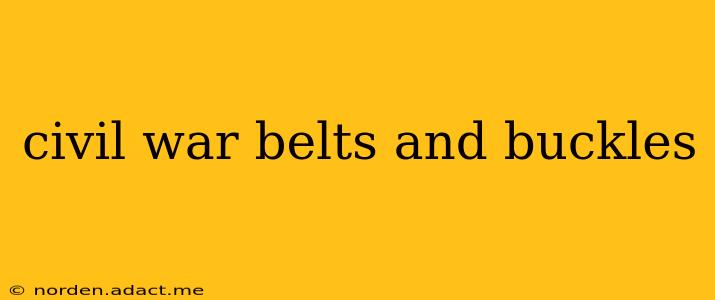The seemingly simple belt and buckle played a surprisingly significant role in the American Civil War. More than just functional accessories, they reflected a soldier's unit, rank, and even personal style, offering a fascinating glimpse into the lives of those who fought. This exploration delves into the various types of belts and buckles used during the conflict, their practical applications, and their historical significance.
What types of belts were used by Civil War soldiers?
Civil War soldiers utilized a variety of belts, primarily categorized by their function:
-
Waist Belts: These were the most common type, worn around the waist to support equipment. Materials ranged from leather (most prevalent) to woven fabrics like canvas or cotton. The quality varied significantly depending on the soldier's means and the availability of supplies. Officer belts tended to be of higher quality leather, often with more elaborate stitching and decoration.
-
Cross Belts: These were used to carry cartridge boxes, canteens, and other essential supplies across the chest and shoulders, distributing the weight more evenly than waist belts alone could manage. They were typically made of leather or strong webbing.
-
Equipment Belts: Specific belts were designed to hold particular items, such as swords, bayonets, or even musical instruments for band members. These often had specialized attachments or features tailored to their purpose.
What were Civil War buckles made of?
Buckles, too, varied in material and design:
-
Brass: A common and relatively inexpensive material, brass buckles were widely used throughout the war. Their durability made them practical for everyday use.
-
Iron: While less common than brass, iron buckles offered superior strength and were often chosen for more demanding applications.
-
Silver and other metals: Officer's belts and buckles were frequently made from silver, gold, or other precious metals, reflecting their rank and status. Elaborate designs and engravings were often incorporated into these higher-quality items.
-
Variations in design: Buckles ranged from simple, functional designs to more ornate styles. Some buckles featured unit insignia, regimental crests, or even patriotic motifs.
How did belts and buckles differ between Union and Confederate soldiers?
While both sides used similar types of belts and buckles in terms of material and function, there were subtle differences:
-
Availability of resources: The Confederacy faced significant shortages of resources throughout the war, meaning Confederate soldiers often had to make do with less durable materials and simpler designs.
-
Manufacturing capabilities: The industrial capacity of the Union allowed for greater standardization and mass production of military equipment, leading to some differences in design and quality compared to the Confederacy.
-
Personalization: Soldiers on both sides often personalized their belts and buckles with engravings, initials, or other markings, reflecting individual preferences and experiences.
What were the different types of Civil War belt plates?
Belt plates, the metal plates attached to the belt, were an important aspect of the overall uniform. They varied considerably depending on the soldier's branch of service, regiment, and even rank. Some featured unit insignia, while others displayed simple designs or were left plain.
What is the value of Civil War belts and buckles today?
The value of Civil War belts and buckles today depends heavily on their condition, rarity, and provenance. Well-preserved examples with identifiable unit markings or associated documentation can command significant prices among collectors. However, many common examples remain affordable, making them accessible to a range of enthusiasts.
Where can I find Civil War belts and buckles?
Civil War belts and buckles can be found at various places, including:
- Antique shops and shows: These are common sources for these items.
- Online auction sites: Websites like eBay often have a wide selection.
- Civil War reenactment events: These events sometimes feature vendors selling related items.
- Museums and historical societies: These organizations may have examples in their collections, although they are typically not for sale.
This comprehensive exploration highlights the practical and historical significance of Civil War belts and buckles, demonstrating their importance as functional equipment and as reflections of the men who wore them. The wide variety of materials, designs, and regional differences provide a unique lens into the realities of life and warfare during this pivotal period in American history.
